
Daviesia divaricata, commonly known as marno, is a species of flowering plant in the family Fabaceae and is endemic to the south-west of Western Australia. It is a low, spreading or erect and bushy shrub with phyllodes reduced to small, triangular scales, and orange and maroon flowers.
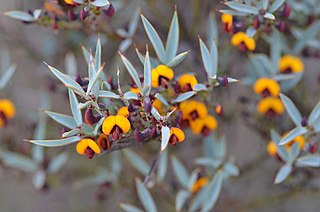
Daviesia nudiflora is a species of flowering plant in the family Fabaceae and is endemic to the south-west of Western Australia. It is a bushy shrub with sharply pointed, egg-shaped to elliptic or oblong phyllodes, and yellow-orange flowers with reddish-brown markings.

Daviesia buxifolia, commonly known as box-leaf bitter-pea, is a species of flowering plant in the family Fabaceae and is endemic to south-eastern continental Australia. It is an open shrub with egg-shaped to round phyllodes and yellow or yellowish-orange and maroon-brown flowers.

Daviesia obovata, commonly known as paddle-leaf daviesia, is a species of flowering plant in the family Fabaceae and is endemic to the south-west of Western Australia. It is an erect, slender shrub with scattered egg-shaped phyllodes with the narrower end towards the base, and yellow flowers with pale green markings.
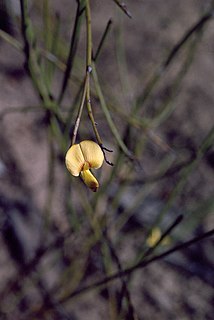
Daviesia anceps is a species of flowering plant in the family Fabaceae and is endemic to the south of Western Australia. It is a dense, erect or low-lying shrub with its branchlets reduced to flattened cladodes, and yellow flowers with red markings.

Daviesia apiculata is a species of flowering plant in the family Fabaceae and is endemic to the south-west of Western Australia. It is an erect, bushy shrub with scattered, erect phyllodes with a point on the end, and yellow flowers with a red tinge.

Daviesia crenulata is a species of flowering plant in the family Fabaceae and is endemic to the south-west of Western Australia. It is a bushy shrub with broadly egg-shaped phyllodes with a sharply-pointed end and wavy edges, and uniformly yellow-orange and maroon flowers.

Daviesia aphylla is a species of flowering plant in the family Fabaceae and is endemic to the south-west of Western Australia. It is an erect, bushy shrub with glabrous foliage, up to six sharply-pointed phyllodes on each branchlet, and orange-red and yellow flowers.

Daviesia elongata is a species of flowering plant in the family Fabaceae and is endemic to the south-west of Western Australia. It is a glabrous, spreading or sprawling shrub with narrowly egg-shaped to linear phyllodes and yellow-orange and maroon flowers.

Daviesia euphorbioides, commonly known as Wongan cactus, is a species of flowering plant in the family Fabaceae and is endemic to a restricted area in the south-west of Western Australia. It is an open, erect to sprawling, cactus-like shrub with thick, fleshy branchlets and phyllodes reduced to scattered, sharply-pointed spines, and bright yellow, reddish-brown and maroon flowers.

Daviesia flexuosa is a species of flowering plant in the family Fabaceae and is endemic to the south-west coast of Western Australia. It is a glabrous, spreading shrub with zig-zagged branchlets, scattered, sharply-pointed, narrowly triangular phyllodes and yellow and red flowers.

Daviesia incrassata is a species of flowering plant in the family Fabaceae and is endemic to the south-west of Western Australia. It is an erect, mounded to spreading shrub with more or less zigzag branchlets, scattered needle-shaped phyllodes and orange, deep red and pink flowers.

Daviesia lancifolia is a species of flowering plant in the family Fabaceae and is endemic to the south-west of Western Australia. It is a prostrate to erect, spreading shrub with egg-shaped, more or less round or linear phyllodes and yellow to orange and red flowers.

Daviesia longifolia is a species of flowering plant in the family Fabaceae and is endemic to the south-west of Western Australia. It is an erect, many-stemmed shrub with scattered, erect, cylindrical phyllodes and yellow and red flowers.
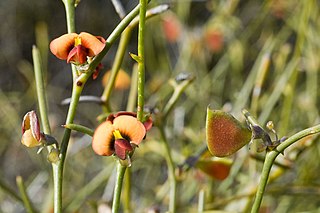
Daviesia major is a species of flowering plant in the family Fabaceae and is endemic to the south-west of Western Australia. It is an erect, many-stemmed shrub with scattered, erect, sharply-pointed, cylindrical phyllodes and orange and red flowers.

Daviesia microphylla is a species of flowering plant in the family Fabaceae and is endemic to the south-west of Western Australia. It is an openly-branched, sprawling shrub with spiny branchlets, crowded, sharply-pointed, egg-shaped phyllodes, and orange, dark red and maroon flowers.
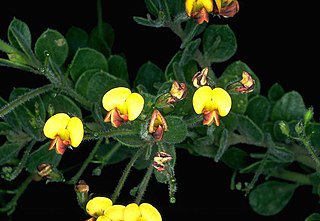
Daviesia mollis is a species of flowering plant in the family Fabaceae and is endemic to the south-west of Western Australia. It is a small shrub with softly-hairy foliage, scattered elliptic phyllodes, and yellow and reddish flowers.
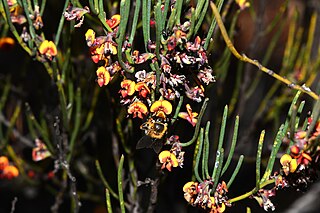
Daviesia nematophylla is a species of flowering plant in the family Fabaceae and is endemic to the south-west of Western Australia. It is a dense, erect shrub with glabrous foliage, erect, usually needle-shaped phyllodes, and yellow, orange and dark red flowers.

Daviesia ovata, commonly known as broad-leaf daviesia, is a species of flowering plant in the family Fabaceae and is endemic to a restricted part of the south-west of Western Australia. It is a dense, bushy, glabrous shrub with egg-shaped to elliptic phyllodes and orange and maroon flowers.

Daviesia oxylobium is a species of flowering plant in the family Fabaceae and is endemic to the south-west of Western Australia. It is an erect, bushy shrub with sharply-pointed, cylindrical phyllodes, and yellow and pinkish-red flowers.



















